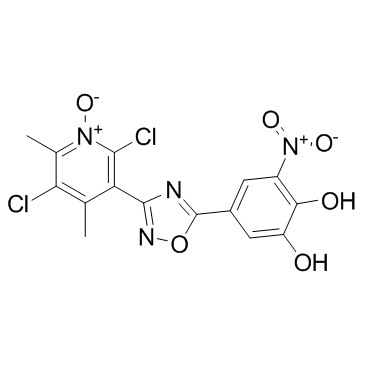| Description |
Opicapone is an available catechol-O-methyltransferase (COMT) inhibitor. Opicapone decreases the ATP content of the cells with IC50 values of 98 μM.
|
| Related Catalog |
|
| Target |
COMT[1]
|
| In Vitro |
Opicapone has a prolonged inhibitory effect on peripheral COMT, which extends the bioavailability of levodopa, without inducing toxicity. Opicapone decreases the ATP content of the cells with IC50 values of 98 μM. Incubation of human primary hepatocytes for 24 h with increasing concentrations of Tolcapone, entacapone or Opicapone resulted in a concentration-dependent decrease in the mitochondrial membrane potential of the cells, evaluated by the ratio JC-1 aggregates over JC-1 monomer (ratio λex 544 λem 590 over λex 485 λem 538). Opicapone decreases the mitochondrial membrane potential of the cells with IC50 of 181 μM[1].
|
| In Vivo |
Opicapone inhibits rat peripheral COMT with ED50 values below 1.4 mg/kg up to 6 h post-administration. The effect is sustained over the first 8 h and by 24 h COMT had not returned to control values. A single administration of Opicapone resulted in increased and sustained plasma levodopa levels with a concomitant reduction in 3-O-methyldopa from 2 h up to 24 h post-administration, while Tolcapone produced significant effects only at 2 h post-administration. The effects of Opicapone on brain catecholamines after levodopa administration are sustained up to 24 h post-administration. Opicapone is also the least potent compound in decreasing both the mitochondrial membrane potential and the ATP content in human primary hepatocytes after a 24 h incubation period[1].
|
| Kinase Assay |
ATP content of human primary hepatocytes is determined using the ATP Lite assay system, which is based on the production of light caused by the reaction of ATP with added luciferase and D-luciferin. Twenty-four hours after being seeded, cell cultures are washed with Hank's balanced salt solution (HBSS) and are then incubated with test compounds prepared in culture media without fetal bovine serum (0, 1.56, 3.13, 6.25, 12.5, 25, 50, 100 and 200 μM) for 24 h at 37°C in humidified 5% CO2-95% air. Positive controls (cells incubated with carbonyl cyanide-p-trifluoromethoxyphenylhydrazone-FCCP, 10 and 50 μM) are run in parallel. After incubation, media are removed from the wells and substituted with 100 μL HBSS plus 50 μL cell lysis solution. Plates are shaken for 5 min at 400 r.p.m. at room temperature. Substrate solution (50 μL) is then added to each well and plates are again shook for 5 min at 400 r.p.m. at room temperature in subdued light. Three standard concentrations of ATP (1, 10 and 100 μM) and blanks are run in parallel in plate wells without cells. Plates are dark adapted for 10 min and luminescence is determined on a MicrobetaTriLux scintillation counter[1].
|
| Animal Admin |
Rats[1] Male Wistar rats (240) are used. In experiments designed to evaluate the efficacy of the compound at inhibiting COMT, animals are administered Opicapone (0.03, 0.1, 0.3, 0.6, 1, 3 and 10 mg/kg) and are killed at 2 and 6 h post-administration. In experiments designed to evaluate COMT time-activity profile, animals are given Opicapone (3 mg/kg) and are killed at different post-administration periods (15 and 30 min, and 1, 2, 4, 8, 18, 24, and 48 h). In experiments designed to evaluate the effects of the compounds on central catecholamines, animals are given 3 mg/kg Opicapone or Tolcapone and 1 h before being killed, animals are administered levodopa/benserazide (levodopa 12 mg/kg and benserazide 3 mg/kg).
|
| References |
[1]. Bonifácio MJ, et al. Pharmacological profile of Opicapone, a third-generation nitrocatechol catechol-O-methyl transferase inhibitor, in the rat. Br J Pharmacol. 2015 Apr;172(7):1739-52.
|
